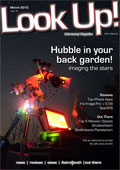Plan your night's viewing using free planetarium software from http://www.stellarium.org/
April Sky 2015
Mercury starts the month poorly placed in the morning sky. The planet reaches superior conjunction on the 9th. From this date Mercury moves towards its position in the evening sky and can be seen on the 14th once the Sun has set. The 19th will be a good time to see Mercury in conjunction with the 1% lit Moon and mag. 1.4 Mars in the west-northwest after sunset. On the 22nd Mercury and Mars are separated by 1.25°.
Venus will be one of the most dominant features in the western sky, blazing away with a magnitude of -4.1. Setting three hours and forty minutes after the Sun at the beginning of the month, Venus continues to climb and, by month’s end, the planet will remain above the horizon before it sets at c.00:25! Venus shows off with the Seven Sisters (2.75° below) on the 10th, the sight should be amazing! Venus is placed between the Seven Sisters and the Hyades clusters on the 14th. From our perspective we will see Venus heading away from the Sun; it will be well worth noting the changing size and phase of the planet during this period.
Mars will soon be lost to the increasing brightness of the twilight sky as it makes its way towards the Sun. Telescopically there isn’t much to see of the red planet but there will be a couple of conjunctions - one on the 19th with the Moon and with Mercury close by, the second one with Mercury, the two of them separated by 1.25° on the 22nd.
Jupiter slowly drifts towards the west and loses a little altitude in the evening sky. The planet offers some dynamic views with the ever changing position of its Galilean moons and turbulent cloud tops; almost any telescope will provide a pleasing view.
Ganymede’s shadow crosses Jupiter’s disk between 22:01 on the 7th and 01:38 BST on the 8th. Europa will annularly occult Callisto on the 8th between 22:54:04 and 22:59:47 BST. Ganymede transits on the 14th at 21:10 and ends 00:46 BST on the 15th. The moon’s shadow follows between 02:01 and 05:38 BST. On the 17th Callisto’s shadow can be seen crossing the disc at 22:15 until 02:57 BST on the 18th.
An annular occultation of Ganymede and Callisto occurs on the morning of the 18th between 02:28:05 and 02:36:55, peaking at 02:32:30 BST.
Saturn remains to be seen in the constellation of Scorpius in the predawn sky. On the 1st the ringed planet lies just 0.5° north of mag.4 binary star Nu Scorpii. The ring system is now tilted by 25%.
Uranus and Neptune will not be visible this month.
Meteors
The Lyrid Meteor shower peaks on the 22nd/23rd and the ZHR is expected to be c.10. With the radiant located close to Vega in Lyra and virtually overhead, the viewing should be excellent.
Moon - Watch – Shoot the Moon
New Moon: 18th April Full Moon: 4th April
The Moon regularly makes close passes to the stars and planets on its monthly trip around the sky; grab your DSLR and shoot the Moon – the results can be impressive!
On the 19th, Mars with the Moon and Mercury after sunset west-northwest. There is a Lunar occultation on the 25th at 00:35 BST with a couple of stars: mag +6.6 TYC1360-1431-1 is the first one to go followed by mag.+5.3 68 Geminorum two minutes later.
Check out our Flickr Group: http://www.flickriver.com/groups/hantsastro/pool/interesting/





